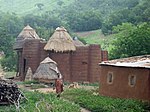List of World Heritage Sites in Togo
Appearance
Location of World Heritage Sites in Togo
The United Nations Educational, Scientific and Cultural Organization (UNESCO) World Heritage Sites are places of importance to cultural or natural heritage as described in the UNESCO World Heritage Convention, established in 1972.[1] Togo accepted the convention on April 15, 1998, making its historical sites eligible for inclusion on the list. As of 2023, Togo has only one World Heritage Site, Koutammakou, the Land of the Batammariba, which it's shared with Benin.[2]
World Heritage Sites
[edit]UNESCO lists sites under ten criteria; each entry must meet at least one of the criteria. Criteria i through vi are cultural, and vii through x are natural.[3]
* Transnational site
| Site | Image | Location | Year listed | UNESCO data | Description |
|---|---|---|---|---|---|
| Koutammakou, the Land of the Batammariba* | 
|
Kara Region | 2004 | 1140bis; v, vi (cultural) | The Koutammakou landscape in north-eastern Togo and neighbouring Benin is home to the Batammariba, whose remarkable mud tower-houses are known as takienta (sikien in the plural). Nature is strongly associated with the rituals and beliefs of society here. The landscape is exceptional due to the architecture of the tower-houses which reflect the social structure; its farmland and forest; and the associations between people and landscape. The buildings are grouped in villages, which also include ceremonial spaces, springs, sacred rocks and sites reserved for initiation ceremonies.[4] |
Tentative List
[edit]| Site | Image | Location | Criteria | Area ha (acre) |
Year of submission | Description |
|---|---|---|---|---|---|---|
| Aného-Glidji Aglomeration | 
|
Maritime Region 6°14′00″N 1°36′00″E / 6.233333°N 1.6°E | Cultural (iii) (iv) | 2021 | [5] | |
| Serial Granaries of the caves of Nok, Mamproug, Kouba and Bagou | 
|
Savanes Region 10°39′21″N 0°11′42″E / 10.655833°N 0.195°E | Cultural (iv) (vi) | 2021 | [6] | |
| Bassar Ancient Iron Metallurgy Sites | 
|
Kara Region 9°15′00″N 0°47′00″E / 9.25°N 0.783333°E | Cultural (iv) (vi) | 2021 | [7] | |
| Fazao Malfakassa National Park | 
|
Centrale Region, Kara Region 9°N 1°E / 9°N 1°E | Natural (x) | 2021 | [8] |
References
[edit]- ^ "The World Heritage Convention". UNESCO. Retrieved December 11, 2023.
- ^ "Togo". UNESCO. Retrieved November 20, 2023.
- ^ "UNESCO World Heritage Centre – The Criteria for Selection". UNESCO World Heritage Centre. Archived from the original on 12 June 2016. Retrieved 17 August 2018.
- ^ "Koutammakou, the Land of the Batammariba". UNESCO World Heritage Centre. Retrieved 2023-11-20.
 Text was copied from this source, which is available under a Creative Commons Attribution 3.0 IGO (CC BY 3.0 IGO) license.
Text was copied from this source, which is available under a Creative Commons Attribution 3.0 IGO (CC BY 3.0 IGO) license.
- ^ "Aného-Glidji Aglomeration". UNESCO World Heritage Centre (in French). Retrieved 2023-11-20.
- ^ "Serial Granaries of the caves of Nok, Mamproug, Kouba and Bagou". UNESCO World Heritage Centre (in French). Retrieved 2023-11-20.
- ^ "Bassar Ancient Iron Metallurgy Sites". UNESCO World Heritage Centre (in French). Retrieved 2023-11-20.
- ^ "Fazao Malfakassa National Park". UNESCO World Heritage Centre (in French). Retrieved 2023-11-20.



